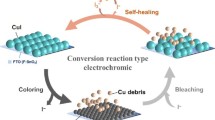Abstract
Ag deposition-based multicolor electrochromic (EC) device we reported can switch various optical states among transparent, black, silver, cyan, magenta, and yellow by only using electrochemical deposition of Ag. However, the EC device had poor color retention property under open-circuit state because of dissolution of deposited Ag metal by Cu2+ ions, which is essential because it acts as redox material at counter electrode. Here, we introduced an anion exchange membrane to separate Cu2+ from the Ag deposit. The improved device achieved longer retention time of colored state. It is effective to maintain the coloring state without electric power for practical application.



Similar content being viewed by others
References
P.M.S. Monk, R.J. Mortimer, and D.R. Rosseinsky: Electrochromism and Electrochromic Devices (Cambridge University Press, Cambridge, England, 2007).
R.J. Mortimer: Organic electrochromic materials. Electrochim. Acta 44, 2971–2981 (1999).
N. Kobayashi, S. Miura, M. Nishimura, and H. Urano: Organic electrochromism for a new color electronic paper. Sol. Energy Mater. Sol. Cells 92, 36–139 (2008).
D.R. Rosseinsky and R.J. Mortimer: Electrochromic systems and the prospects for devices. Adv. Mater. 13, 783–793 (2001).
H. Urano, S. Sunohara, H. Ohtomo, and N. Kobayashi: Electrochemical and spectroscopic characteristics of dimethyl terephthalate. J. Mater. Chem. 14, 2366–2368 (2004).
A.A. Argun, P.H. Aubert, B.C. Thompson, I. Schwendeman, C.L. Gaupp, J. Hwang, N.J. Pinto, D.B. Tanner, A.G. MacDiarmid, and J. R. Reynolds: Multicolored electrochromism in polymers: structures and devices. Chem. Mater. 16, 4401–4412 (2004).
K. Imaizumi, Y. Watanabe, K. Nakamura, T. Omatsu, and N. Kobayashi: Multicolored electrochromism in 4,40-biphenyl dicarboxylic acid diethyl ester. Phys. Chem. Chem. Phys. 13, 11838–11840 (2011).
E. Unur, J.-H. Jung, R.J. and J.R. Reynolds: Dual-polymer electrochromic film characterization using bi potentiostatic control. Chem. Mater. 20, 2328–2334 (2008).
Y. Naijoh, T. Yashiro, S. Hirano, Y. Okada, S. Kim, K. Tsuji, H. Takahashi, K. Fujimura, and H. Kondoh: Multi-layered electrochromic display. IDW 11, 375–378 (2011).
S. Yokogawa, S.P. Burgos, and H.A. Atwater: Plasmonic color filters for CMOS image sensor applications. Nano Lett. 12, 4349–4354 (2012).
S.J. Tan, L. Zhang, D. Zhu, X.M. Goh, Y.M. Wang, K. Kumar, C-W. Qiu, and J.K. Yang: Plasmonic color palettes for photorealistic printing with aluminum nanostructures. Nano Lett. 14, 4023–4029 (2014).
K. Kumar, H. Duan, R.S. Hegde, S.C.W. Koh, J.N. Wei, and J.K.W. Yang: Printing colour at the optical diffraction limit. Nat Nanotechnol. 7, 557–561 (2012).
S. Araki, K. Nakamura, K. Kobayashi, A. Tsuboi, and N. Kobayashi: Electrochemical optical-modulation device with reversible transformation between transparent, mirror, and black. Adv. Mater. 14, 122–126 (2012).
A. Tsuboi, K. Nakamura, and N. Kobayashi: A localized surface plasmon resonance-based multicolor electrochromic device with electrochemically size-controlled silver nanoparticles. Adv. Mater. 25, 3197–3201 (2013).
A. Tsuboi, K. Nakamura, and N. Kobayashi: Multicolor electrochromism showing three primary color states (cyan-magenta-yellow) based on size- and shape-controlled silver nanoparticles. Chem. Mater. 26, 6477–6485 (2014).
R. Onodera, A. Tsuboi, K. Nakamura, and N. Kobayashi: Coloration mechanisms of Ag deposition-based multicolor electrochromic device investigated by morphology of Ag deposit and its optical properties. J. SID 24, 424–432 (2016).
G. Sandmann, H. Dietz, and W. Plieth: Preparation of silver nanoparticles on ITO surfaces by a double-pulse method. J. Electroanal. Chem. 491, 78–86 (2000).
M. Ueda, H. Dietz, A. Anders, H. Kneppe, A. Meixner, and W. Plieth: Double-pulse technique as an electrochemical tool for controlling the preparation of metallic nanoparticles. J. Electrochim. Acta 48, 377–386 (2002).
A. Safavi, N. Maleki, and E. Farjami: Electrodeposited silver nanoparticles on carbon ionic liquid electrode for electrocatalytic sensing of hydrogen peroxide. Electroanalysis 21, 1533–1538 (2009).
K. Wang, H. Wu, Y. Meng, Y. Zhang, and Z. Wei: Integrated energy storage and electrochromic function in one flexible device: an energy storage smart window. Energy Environ. Sci. 5, 8384–8389 (2012).
Y-Y. Song, Z-D. Gao, J-H. Wang, X-H. Xia, and R. Lynch: Multistage coloring electrochromic device based on TIO2 nanotube arrays modified with WO3 nanoparticles. Adv. Fund. Mater. 21, 1941–1946 (2011).
Y. Tian, W. Zhang, S. Cong, Y. Zheng, F. Geng, and Z. Zhao: Unconventional aluminum ion intercalation/deintercalation for fast switching and highly stable electrochromism. Adv. Fund. Mater. 25, 5833–5839 (2015).
C-P. Li, C. Engtrakul, R.C. Tenent, and C.A. Wolden: Scalable synthesis of improved nanocrystalline, mesoporous tungsten oxide films with exceptional electrochromic performance. Sol. Energy Mater. Sol. Cells 132, 6–14 (2015).
G.A. Niklasson, and C.G. Granqvist: Electrochromics for smart windows: thin films of tungsten oxide and nickel oxide, and devices based on these. J. Mater. Chem. 17, 127–156 (2007).
C.G. Granqvist: Electrochromics for smart windows: oxide-based thin films and devices. Thin Solid Films 564, 1–38 (2014).
C.M. Lampert: Chromogenic smart materials. Mater. Today 7, 28–35 (2004).
Author information
Authors and Affiliations
Corresponding author
Rights and permissions
About this article
Cite this article
Kimura, S., Onodera, R., Nakamura, K. et al. Improvement of color retention properties of Ag deposition-based electrochromic device by introducing anion exchange membrane. MRS Communications 8, 498–503 (2018). https://doi.org/10.1557/mrc.2018.55
Received:
Accepted:
Published:
Issue Date:
DOI: https://doi.org/10.1557/mrc.2018.55




